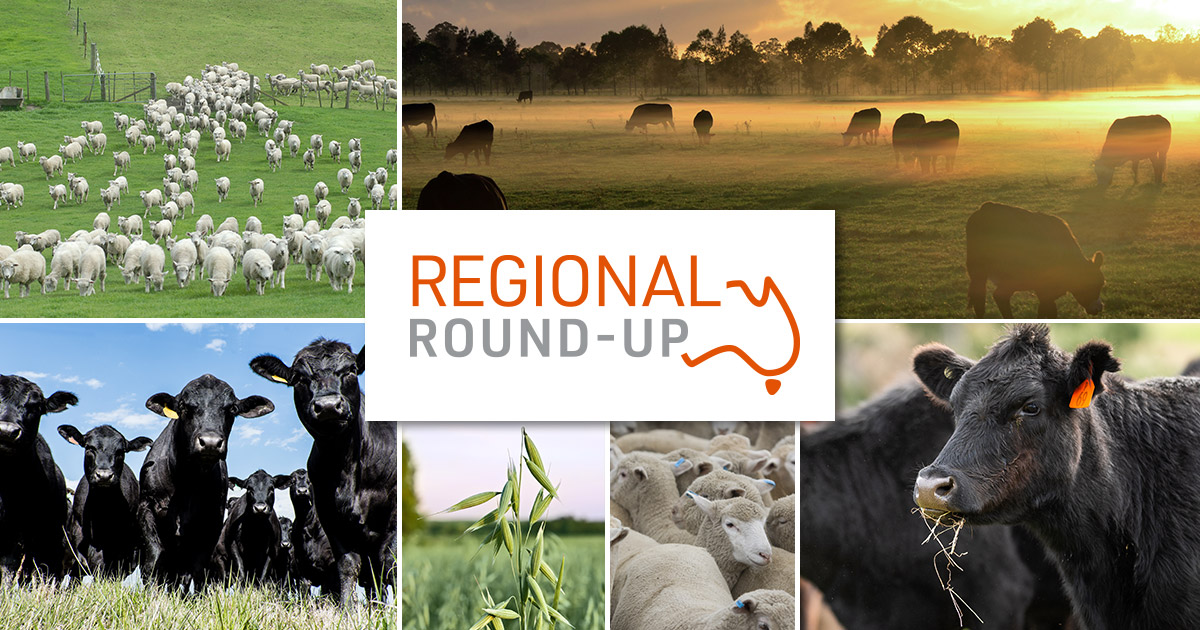Welcome to this month’s regional round-up – a glimpse of what’s going on in the paddocks right across Australia…
 |
National overview – Chris Howie Currently all the states, including South Australia and Western Australia, are quite wet, and there’s an expectation that more rain through August will start to create some water-logging issues with crop and pastures. Continued wet and cold conditions have seen livestock weight-gains slow down, with feed growth retarded by short days.Nearly all areas now have grazing grass, although it’s still quite short. New South Wales grazing crops are very good, and have provided backgrounders the opportunity to carry cattle well into August and September in order to maximise weight for age.Feeder steers and heifers continue to trade between $5.40-$6 per kg, depending on the breed. Most feedlots are very keen to secure numbers, which has seen some flexibility appear around minimum numbers and delivery points. Once numbers begin to appear, the supply specifications historically begin to tighten. Heavy cows 700kg+ have made up to $3.99 per kg liveweight, which is an exceptional return for older cows. Cows and calf units are eagerly sought to restock and provide a multiple option purchase. Bull sales continue to exceed all expectations following last year’s fantastic sale series, and the highlight to date is the Texas Angus bull Texas Iceman R725 making $225,000.Very good sucker lambs are starting to appear at Dubbo, Forbes and Wagga. Best lambs are very fresh – estimated at 24-25kg dressed – and are making $9.50-$10/kg with a $10-$12 skin. Mutton continues to trade across all areas at very good levels of $7 and better. Merino skins have been attracting good competition as well, returning $18-$23. July and early August are always periods of short supply, and considering locking some prices in for spring delivery at this time of the year is very sound business.Finally, many areas are now seeing considerable water in catchments, low areas, water courses and swamps. With any substantial rain there will be a high risk of flooding in many areas over the next six weeks. |
 |
Queensland – Angus Creedon Currently we’re in the thick of winter, with much of northern New South Wales reporting wet and cold conditions. Queensland has responded well to the recent rainfall, with a lot of southern and central Queensland looking nice and green.The cold and wet weather in New South Wales means weight gains have eased, and many producers are now hanging out for the arrival of spring. Central and southern Queensland has a good moisture profile leading into spring, with the hopes of early rain in September and October. Northern and western Queensland is patchy, with the majority of areas being dry.Livestock prices have continued to increase over the past month off the back of tight supply, and many people in New South Wales are looking to stock up before spring hits. The majority of the weaner sales have now finished, and we’re seeing the tail end of this year’s weaner drop hit the market. These weaners, however, are still achieving great prices. |
 |
NSW – Toby Hammond Most parts of New South Wales have experienced a number of cold fronts, which have brought large amounts of rain. Reports have shown that a lot of central and southern New South Wales has experienced above-average rainfall for July, and forecasts are predicting a similar trend will continue into August and start of Spring.These conditions have delayed livestock’s weight-gain performance, due to the stock focusing energy on keeping warm rather than grazing crop or pasture and putting on weight. There are lots of reports of foot sores in sheep, which is quite normal for this time of year, however it’s been further exacerbated due to the increase in the wet ground. Whilst being a challenging period for management practices, there’s a lot of optimism that – once sunny weather is upon us – both livestock and feed will bounce well away.I mentioned in last month’s regional round-up just how mild winter was, and the performance in both grass growth and livestock performance has remained fairly consistent. However, similar to last year, a vast region of the state is in a great position heading into spring, which will mean a surplus of feed and high demand to put mouths on it.Currently the prices for lamb and mutton are very strong. Some saleyard buyers have been reporting that trade lambs are fetching as much as $10.00/kg (cwt) and over-the-hook prices for mutton are creeping above the $7.00/kg (cwt) territory. With the skin prices bouncing back, there are some very positive results being reported when viewed as a $$/hd price.Cattle still remain strong across the board. Processors have been reporting well into the $8.00/kg (cwt) for killable steers and heifers and feeder prices have shot up into the mid $5/kg (lwt). Again looking at it as a $$/hd value, there are some astonishing figures being reported. This is a completely different scenario compared to this time last year, when COVID-19 cases started occurring in abattoirs throughout Victoria, and the lamb and mutton market took a dive to $6.00/kg (cwt) for lamb. Back then, you were lucky to find $5.00/kg (cwt) for mutton, not to mention the supply build-up it caused. With it being so wet and hard to find well-finished stock, the shortage has occurred and we’ve seen the market bounce up again.Overall this month, I’ve definitely noticed a shift in producers looking for PTIC cows or heifers, or something that already has a calf at foot. I think people are trending this way as a means of managing risk and creating options if we do see the market soften. |
 |
Victoria – Michael Phelan More rain throughout much of Victoria over the last month has seen some areas become quite wet, especially those that received good early rains throughout March and April. In the west, after a very slow start, significant falls have helped the season catch up somewhat, and it’s amazing that – with a bit of help from fertiliser applications – many broadacre crops are now not so far behind what we’d see during an average season. Pastures that haven’t had a chance to rest in the drier regions are still struggling a little however. With the rain has come a fair dose of wind, but as the old saying goes, “Wind brings weather”.Those that have received early rain and were able to establish a feed wedge going into the winter months are in a great position – and the feed just keeps coming. There have, however, been reports in the wetter regions of animal nutrition issues associated with these types of conditions. For example, cases of listeria in sheep have been reported, which is caused by the feeding of mouldy hay or silage which has essentially started to rot. Very wet conditions can cause issues with management as it can delay the mustering of stock if conditions aren’t suitable and there are no breaks in the weather, making it difficult to give animals the attention they need. This is where growers who have bitten the bullet and invested in such things as undercover yards, laneways and pasture management can get ahead.In regions where it was a very dry start to the year, pastures are still struggling to get away, with stock quickly nipping off whatever is coming through – even if growers have the ability to graze on rotation. This is causing ewes and young lambs to come back a bit in their condition – however, with the moisture profile filling up, a good spring flush should help stock catch up a little bit in these areas. It’s certainly not uncommon to have some horrible conditions in the middle of winter but it is a good reminder that things can get wet – and they can get whole lot wetter than what they are now in Victoria. A quiet period during the middle of winter has sheep prices remaining steady across the board, with cattle seemingly finding another gear of late – especially in female stock of PTIC heifers or cows with calves at foot. In general, everything remains very strong at present. As new-season sucker lambs start making their way onto the market in the next 3-4 weeks, it’ll be interesting to see what level of pricing we can expect through this period, with re-stockers and feed lotters keen to know what they’ll need to pay to secure store lambs.Finally, we’re doing a lot of work to set people up with finance for the busy period in the spring months, so they’re organised and not caught on the hop when opportunities start presenting themselves in the coming months. |





